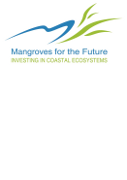Grants :: Small Grant Facilities :: Moklan, the Ethnic Group of the Andaman
Moklan, the Ethnic Group of the Andaman

A group of core students in Baan Lam Kaen School. © GEF SGP Thailand/ Suwimol Serepaowong, 2012.
Objectives
1. To build capacity of the CBOs and women & youth group on marine & coastal resources together with other groups in target location
2. To equip communities against disasters and climatic variability
3. To formulate learning process and encourage establishment of efficient youth group
Background
Save Andaman Network Foundation: Established on 28 December 2004 to play coordinating role of partner organizations in launching relief effort for the Tsunami victims in 121 villages in the 6 affected provinces. The coordination for relief is community-based focusing on quick recovery and further advance than before. The foundation is staffed with experience personnel of NGO nature active in the southern region, especially on the issue of marine and coastal resources management. Simultaneously, the foundation has launched research activity on livelihood recovery and sustainability of resources.
Target beneficiaries
185 out of 650 households of Moklan cultural group, who earn living through providing general services, small business and fishery. The per capita income is THB: 73,000.
Outputs
Expected Outputs
|
Main Activities (กิจกรรม) |
Main Anticipated Result (ผลที่คาดว่าจะได้รับ) |
|
1. Launching youth-led resources inventory, pattern of natural disaster and climatic variance followed by participatory analysis 2. Conducting study tours RE: natural resources management, community rights and management of local natural resources and natural disaster 3. Organizing training RE: community rights, democracy and decentralization , and laws relevant to natural resources management 4. Launching deforestation of mangrove and beach forest followed by close monitor and restoration 5. Launching campaign and meeting summary on conservation of natural resources and relevant community regulations |
1. Increased capacity and conservation awareness of 4 groups of CBOs, and women & youth groups in management of natural resources and natural disasters, witnessed through active participation in project activities 2. Established learning place for conservation of mangrove, beach forest , as habitat for marine species and natural disaster baffle, as follows: - 3.5 ha of mangrove - 120 ha of mangrove and beach forest - 8 ha of terrestrial forest 3. Systematic cooperation in natural resources management among local government agencies and communities 4. Emergence of community regulations for the management of local natural resources 5. An mangrove of about 80 ha being demarcated with signboards to remind public about community regulations |
Accomplishments and challenges
1) Giving roles to community leaders in each location to play in planning and conducting activities was the key factor. Support from other stakeholders was only complementary.
2) Conduction of study on mangrove management and establishment of community forest against relevant laws should be carried out.
3) There are complicated conflicts and issues interfered in the area, namely conflict community land rights, unregulated fishing, ineffective rules and regulations, for example
Contributions to cross-cutting themes
Gender equality
- Updated knowledge and capacity building transferred to targeted population were community rights in democracy, decentralization, natural resources management and rules, disaster management and climate change with adaptation. As the results, there were 4 youth groups and a network of women groups emerged eventually with common understanding and readiness of these topics towards their own management and activities rolled out.
- As Moklan is a sea minority group whose livelihood and culture is unique, and nature-loving. However, this style of livelihood had been overshadowed by globalization and mainstream socialization. For mainstreaming, this project had contributing to shedding light on it by involving Moklan as a key stakeholder and advocating their essential knowledge based on community rights, natural resources management and conservation. As the result, Moklan was one of important leader group to protect the community forest that is acknowledged to public.
Lessons Learned
1. Making use of diverse cultures and ways of lives of different groups to ensure optimal participation in implementing project activities was assessed as satisfactory, to a certain level.
2. As Moklan is a unique cultural group, and in nature, with different level of capacity to learn and acknowledge outside society, the project was a good opportunity for mutual learning and recognition.
3. Natural and simple way of life and mentality of elder Moklan made some of them have different level of recognizing outside society, while a group of women was able to play a leading role in conservation. Youth groups appeared to link both old and new system successfully and play a leading role in community development and management of the project.
Therefore, youth was a messenger linking Moklan way of life and globalization.
Project Facts
Country
Location
Low land area along the Andaman coast of about 6,000 sq.km in Takuapa district, Phang Nga province.
Topic
Duration
19th Jun 2012 to 31st Aug 2013
MFF Grant Amount
300,000 THB
Co-financing Partner
|
From (งบจาก) |
In cash (เงินสด) |
In kind (แรงงาน สิ่งของเครื่องใช้ ที่ดิน ฯลฯ) |
|
Andaman Project for Participatory Restoration of Natural Resources |
- |
213,000 |
|
Marine and Coastal Resources Conservation Centre 5 |
- |
6,000 |
|
Save Andaman Network Foundation |
137,000 |
111,000 |
|
Tsunami Victim Community Network in Phang Nga |
- |
8,000 |
|
Total (THB) |
137,000 |
338,000 |
Implementing Partner
Mr. Pakpoom Witantirawat, Project Leader, 35/1, Moo 5, Tambon Kaunpring, Muang District, Trang Province, 92000.
Related Publications

Moklan, the Ethnic Group of the Andaman
Author: MFF Thailand
Posted on: 4th Dec 2013
Category:
Size: 794 KB